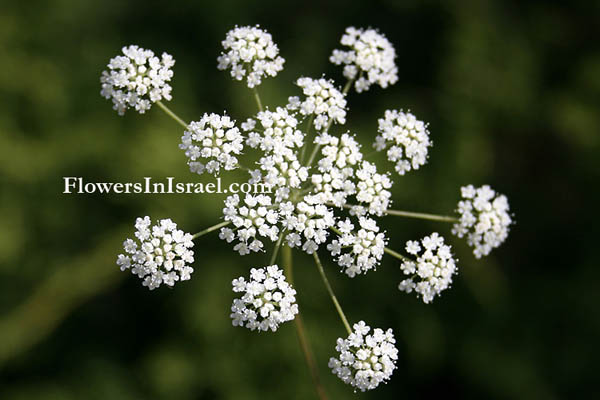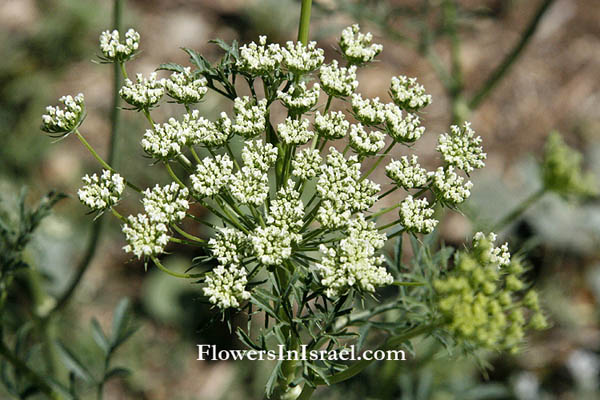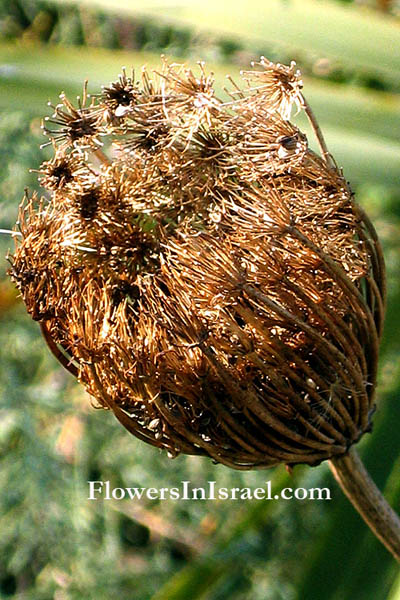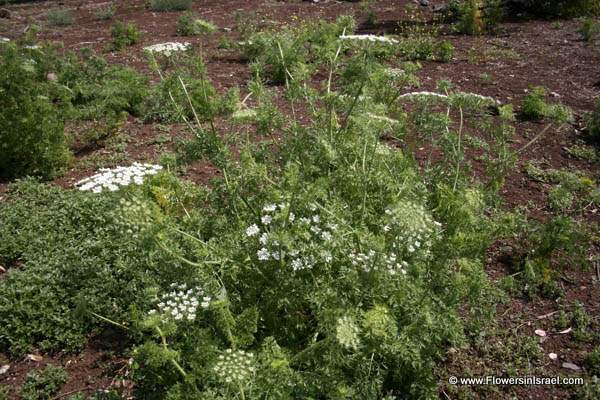
| Scientific name: | Ammi visnaga (L.) Lam. | |
| Synonym name: | Daucus visnaga L. | |
| Common name: | Khella, Bishop's weed, Tooth pick | |
| Hebrew name: | אמיתה קיצית, Amita Keitzit | |
| Arabic name: | الخلة البلدية | |
| Egypt: | خلة بلدى "Khilla Baladi" | |
| Family: | Umbelliferae / Apiaceae, סוככיים |

|
| Life form: | Annual | |
| Stems: | Up to 100 cm high; stems erect, highly branched | |
| Leaves: | Alternate, rosette, dissected twice or more | |
| Flowers: | Hermaphrodite; umbellate; rays, white flowers, highly swollen at the base, become woody and are used as toothpicks | |
| Fruits / pods: | Tiny fruits, which are picked and dried for use in herbal medicines; the seeds contain a fatty oil, which includes khellin | |
| Flowering Period: | April, May, June, July, August | |
| Habitat: | Heavy soils | |
| Distribution: | Mediterranean Woodlands and Shrublands, Semi-steppe shrublands, Shrub-steppes | |
| Chorotype: | Mediterranean | |
| Summer shedding: | Ephemeral |

Derivation of the botanical name: Ammi (Dioscorides), from the Greek term ammos meaning “sand” and refers to the plant’s habitat. visnaga is alleged to have developed from the term “bis acutum” meaning “doubly pointed”. The Hebrew word: אמיתה, amita is mentioned in the Tosefta (Jewish Babylonian Aramaic תוספתא "supplement, addition"; created / edited in Talmudic Israel (approximately 190 - 230 AD)) as a spice plant: "וכן באמיתא וכן בפיגם וכן בשאר מיני תבלין. מאי אמיתה ניניא", "And in Amita and in Pigm and in other kinds of spice. May true Amina Nina". The Arabic name, khella is used throughout the Middle East.
Ammi visnaga is a bitter, aromatic plant that is native to the Mediterranean area of North Africa and the Middle East. The plant grows erect to a height of about 1 meter by 0.5 meters wide and bears wispy leaves, the lower leaves 1-2-pinnate; upper leaves 2-3(4)-pinnate; all leaves with linear to filiform (thread-like) segments. It has clusters of small white scented hermaphrodite flowers, pollinated by Insects. and tiny fruits, which are picked and dried and used in herbal medicines. This plant is self fertile, tastes like thyme, and the leaves are chewed for their flavor in some countries. Ammi visnaga is one of the oldest herbs cultivated by the ancient Egyptians. The seeds are harvested in late summer before they have fully ripened and are dried for later use. They contain a fatty oil that includes the substance 'khellin' (khellin, has vasodilator and bronchodilator properties). The seeds of the Ammi visgana are diuretic and lithotripic and used in the treatment of asthma, angina, coronary arteriosclerosis and kidney stones. This traditional Arab remedy was mentioned in the Ebers papyrus (1500 BCE). In 700 BCE the Indian physician Charaka writes Charaka Samhita, which details over 350 herbal medicines including Ammi visnaga. See the list of Medicinal herbs in Israel, the parts used and their medical uses to treat various diseases. 

|